Self-Assembly by Tridentate or Bidentate Ligand: Synthesis and Vapor Adsorption Properties of Cu(II), Zn(II), Hg(II) and Cd(II) Complexes Derived from a Bis(pyridylhydrazone) Compound
Abstract
:1. Introduction
2. Results and Discussion
2.1. Description of Crystal Structures
2.1.1. Crystal Structure of Complex 1
2.1.2. Crystal Structure of Complexes 2 and 3
2.1.3. Crystal Structure of Complex 4
2.1.4. Structural Comparison
2.2. TG Analyses of the Complexes
2.3. Adsorption Measurements of the Complexes
3. Experimental Section
3.1. Materials and Physical Measurements
3.2. Synthesis
3.2.1. Synthesis of the Ligand
3.2.2. Synthesis of Complexes 1–4
3.3. Crystallographic Data Collection and Structure Determination
4. Conclusions
Supplementary Materials
Author Contributions
Funding
Data Availability Statement
Conflicts of Interest
References
- Khandar, A.A.; Afkhami, F.A.; Yazdi, S.A.H.; Lipkowski, J.; Dougherty, W.G.; Kassel, W.S.; Prieto, H.R.; Granda, S.G. Synthesis, characterization and crystal structure of Zn(II) and Cd(II) One- and two-dimensional coordination polymers derived from pyridine based schiff base ligand. J. Inorg. Organomet Polym. 2015, 25, 860–868. [Google Scholar] [CrossRef]
- Afkhami, F.A.; Khandar, A.A.; Mahmoudi, G.; Maniukiewicz, W.; Lipkowski, J.; White, J.M.; Waterman, R.; Granda, S.G.; Zangrando, E.; Bauzá, A.; et al. Synthesis, X-ray characterization, DFT calculations and Hirshfeld surface analysis of Zn(II) and Cd(II) complexes based on isonicotinoylhydrazone ligand. CrystEngComm 2016, 18, 4587–4596. [Google Scholar] [CrossRef]
- Bhaskar, R.S.; Ladole, C.A.; Salunkhe, N.G.; Barabde, J.M.; Aswar, A.S. Synthesis, characterization and antimicrobial studies of novel ONO donor hydrazone Schiff base complexes with some divalent metal (II) ions. Arab. J. Chem. 2020, 13, 6559–6567. [Google Scholar] [CrossRef]
- Singh, R.K.; Singh, A.K.; Siddiqui, S.; Arshad, M.; Jafri, A. Synthesis, molecular structure, spectral analysis and cytotoxic activity of two new aroylhydrazones. J. Mol. Struct. 2017, 1135, 82–97. [Google Scholar] [CrossRef]
- Çınarlı, M.; Ataol, Ç.Y.; Çınarlı, E.; Idil, Ö. Synthesis, characterization, biological, X-ray diffraction analysis and computational chemistry studies of new 2-acetylpyridine derivative hydrazone and its Zn(II) complex. J. Mol. Struct. 2020, 1213, 128152. [Google Scholar] [CrossRef]
- Wang, L.; Guo, D.G.; Wang, Y.Y.; Zheng, C.Z. 4-Hydroxy-3-methoxy-benzaldehyde series aroyl hydrazones: Synthesis, thermostability and antimicrobial activities. RSC Adv. 2014, 4, 58895–58901. [Google Scholar] [CrossRef]
- Kenđel, A.; Miljanić, S.; Kontrec, D.; Soldin, Ž.; Galić, N. Copper(II) complexes of aroylhydrazones: Preparation and structural characterization. J. Mol. Struct. 2020, 1207, 127783. [Google Scholar] [CrossRef]
- Kamatchi, T.S.; Subarkhan, M.K.M.; Ramesh, R.; Wang, H.X.; Małecki, J.G. Investigation into antiproliferative activity and apoptosis mechanism of new arene Ru(II) carbazole-based hydrazone complexes. Dalton Trans. 2020, 49, 11385–11395. [Google Scholar] [CrossRef]
- Abouzayed, F.I.; Emam, S.M.; Abouel-Enein, S.A. Synthesis, characterization and biological activity of nano-sized Co(II), Ni(II), Cu(II), Pd(II) and Ru(III) complexes of tetradentate hydrazone ligand. J. Mol. Struct. 2020, 1216, 128314. [Google Scholar] [CrossRef]
- Santiago, P.H.O.; Santiago, M.B.; Martins, C.H.G.; Gatto, C.C. Copper(II) and zinc(II) complexes with Hydrazone: Synthesis, crystal structure, Hirshfeld surface and antibacterial activity. Inorg. Chim. Acta 2020, 508, 119632. [Google Scholar] [CrossRef]
- Xu, J.; Zhou, T.; Xu, Z.Q.; Gu, X.N.; Wu, W.N.; Chen, H.; Wang, Y.; Jia, L.; Zhu, T.F.; Chen, R.H. Synthesis, crystal structures and antitumor activities of copper(II) complexes with a 2-acetylpyrazine isonicotinoyl hydrazone ligand. J. Mol. Struct. 2017, 1128, 448–454. [Google Scholar] [CrossRef]
- Yang, Q.Y.; Cao, Q.Q.; Qin, Q.P.; Deng, C.X.; Liang, H.; Chen, Z.F. Syntheses, crystal structures, and antitumor activities of Copper(II) and Nickel(II) complexes with 2-((2-(Pyridin-2-yl)hydrazono)methyl)quinolin-8-ol. Int. J. Mol. Sci. 2018, 19, 1874. [Google Scholar] [CrossRef] [PubMed] [Green Version]
- Santos, A.F.; Ferreira, I.P.; Pinheiro, C.B.; Santos, V.G.; Lopes, M.T.P.; Teixeira, L.R.; Rocha, W.R.; Rodrigues, G.L.S.; Beraldo, H. [Ag(L)NO3] complexes with 2-Benzoylpyridine-derived Hydrazones: Cytotoxic activity and interaction with biomolecules. ACS Omega 2018, 3, 7027–7035. [Google Scholar] [CrossRef] [PubMed]
- Ramachandran, E.; Gandin, V.; Bertani, R.; Sgarbossa, P.; Natarajan, K.; Bhuvanesh, N.S.P.; Venzo, A.; Zoleo, A.; Glisenti, A.; Dolmella, A.; et al. Synthesis, characterization and cytotoxic activity of novel copper(II) complexes with aroylhydrazone derivatives of 2-Oxo-1,2-dihydrobenzo[h] quinoline-3-carbaldehyde. J. Inorg. Biochem. 2018, 182, 18–28. [Google Scholar] [CrossRef]
- Bergamini, F.R.G.; Nunes, J.H.B.; Carvalho, M.A.; Ribeiro, M.A.; Paiva, P.P.; Banzato, T.P.; Ruiz, A.L.T.G.; Carvalho, J.E.; Lustri, W.R.; Martins, D.O.T.A.; et al. Polynuclear copper(II) complexes with nalidixic acid hydrazones: Antiproliferative activity and selectivity assessment over a panel of tumor cells. Inorg. Chim. Acta 2019, 484, 491–502. [Google Scholar] [CrossRef]
- Rocha, C.S.; Filho, L.F.O.B.; Souza, A.E.; Diniz, R.; Denadai, Â.M.L.; Beraldo, H.; Teixeira, L.R. Structural studies and investigation on the antifungal activity of silver(I) complexes with 5-nitrofuran-derived hydrazones. Polyhedron 2019, 170, 723–730. [Google Scholar] [CrossRef]
- Bakale, R.P.; Naik, G.N.; Machakanur, S.S.; Mangannavar, C.V.; Muchchandi, I.S.; Gudasi, K.B. Structural characterization and antimicrobial activities of transition metal complexes of a hydrazone ligand. J. Mol. Struct. 2018, 1154, 92–99. [Google Scholar] [CrossRef]
- Mahmoud, A.G.; Silva, M.F.C.G.; Mahmudov, K.T.; Pombeiro, A.J.L. Arylhydrazone ligands as Cu-protectors and -catalysis promoters in the azide–alkyne cycloaddition reaction. Dalton Trans. 2019, 48, 1774–1785. [Google Scholar] [CrossRef]
- Wu, Y.; Gu, Z.J.; Luo, W.; Wu, L.; Li, Y.L.; Xie, B.; Zuo, L.K. Crystal structure, luminescent sensing and photocatalytic activity of a multifunctional hydrazone-based zinc(II) coordination polymer. Transit. Metal Chem. 2018, 43, 673–681. [Google Scholar] [CrossRef]
- Chen, D.M.; Wu, X.F.; Liu, Y.J.; Huang, C.; Zhu, B.X. Synthesis, crystal structures and vapor adsorption properties of Hg(II) and Cd(II) coordination polymers derived from two hydrazone Schiff base ligands. Inorg. Chim. Acta 2019, 494, 181–186. [Google Scholar] [CrossRef]
- Matoga, D.; Szklarzewicz, J.; Nitek, W. Effect of ligand substituents on supramolecular self-assembly and electrochemical properties of copper(II) complexes with benzoylhydrazones: X-ray crystal structures and cyclic voltammetry. Polyhedron 2012, 36, 120–126. [Google Scholar] [CrossRef]
- Chelike, D.K.; Alagumalai, A.; Muthukumar, V.R.; Thangavelu, S.A.G.; Krishnamoorthy, A. Tunable yellow–green emitting cyclotriphosphazene appended phenothiazine hydrazone hybrid material: Synthesis, characterisation, photophysical and electrochemical studies. New J. Chem. 2020, 44, 13401–13414. [Google Scholar] [CrossRef]
- Sathiyakumar, S.; Selvam, P.; Hakkim, F.L.; Srinivasan, K.; Harrison, W.T.A. Mechanochemical syntheses, crystal structures, and photo-luminescent properties of a new hydrazone and its nickel and cadmium complexes. J. Coord. Chem. 2018, 71, 3521–3533. [Google Scholar] [CrossRef] [Green Version]
- Sennappan, M.; Krishna, P.M.; Hosamani, A.A.; Krishna, R.H. Synthesis, characterization, nucleic acid interactions and photoluminescent properties of methaniminium hydrazone Schiff base and its Mn(II), Co(II), Ni(II), Cu(II), Zn(II) and Cd(II) complexes. J. Mol. Struct. 2018, 1164, 271–279. [Google Scholar] [CrossRef]
- Warr, R.J.; Willis, A.C.; Wild, S.B. Inorganic asymmetric synthesis: Diastereoselective syntheses of Monoand dinuclear complexes containing octahedral, two-bladed propeller, Bis(pyridine-2-aldehyde 2′-pyridylhydrazone)iron(II) Stereocenters. Inorg. Chem. 2008, 47, 9351–9362. [Google Scholar] [CrossRef] [PubMed]
- Nakamura, T.; Kimura, H.; Okuhara, T.; Yamamura, M.; Nabeshima, T. A Hierarchical Self-Assembly System Built Up from Preorganized Tripodal Helical Metal Complexes. J. Am. Chem. Soc. 2016, 138, 794–797. [Google Scholar] [CrossRef] [PubMed]
- Chaur, M.N.; Collado, D.; Lehn, J.M. Configurational and constitutional information storage: Multiple dynamics in systems based on Pyridyl and Acyl Hydrazones. Chem. Eur. J. 2011, 17, 248–258. [Google Scholar] [CrossRef]
- Nesterova, O.V.; Chygorin, E.N.; Kokozay, V.N.; Bon, V.V.; Omelchenko, I.V.; Shishkin, O.V.; Titiš, J.; Boča, R.; Pombeiro, A.J.L.; Ozarowski, A. Magnetic, high-field EPR studies and catalytic activity of Schiff base tetranuclear CuII2 FeIII2 complexes obtained by direct synthesis. Dalton Trans. 2013, 42, 16909–16919. [Google Scholar] [CrossRef]
- Chen, L.D.; Huo, H.L.; Ma, L.L.; Jiang, Y.; Xie, J.Y.; Wang, J. Nickel complexes based on Salicylaldehyde-imine ligands: Synthesis, characterization and catalytic oligomerization of Ethylene. Chem. Res. Chin. Univ. 2018, 34, 945–951. [Google Scholar] [CrossRef]
- Sarkar, R.; Hens, A.; Rajak, K.K. Synthesis, characterization and DFT study of oxorhenium(V) complexes incorporating quinoline based tridentate ligands. RSC Adv. 2015, 5, 15084–15095. [Google Scholar] [CrossRef]
- Andrezálová, L.; Plšíková, J.; Janocková, J.; Koñariková, K.; Žitñanová, I.; Kohútová, M.; Kožurková, M. DNA/BSA binding ability and genotoxic effect of mono- and binuclear copper (II) complexes containing a Schiff base derived from salicylaldehyde and D, L-glutamic acid. J. Organomet. Chem. 2017, 827, 67–77. [Google Scholar] [CrossRef]
- Addison, A.W.; Rao, T.N.; Reedijk, J.; van Rijn, J.; Verschoor, G.C. Synthesis, structure, and spectroscopic properties of copper(II) compounds containing nitrogen–sulphur donor ligands; the crystal and molecular structure of aqua[1,7-bis(N-methylbenzimidazol-2’-yl)-2,6-dithiaheptane]copper(II) perchlorate. J. Chem. Soc. Dalton Trans. 1984, 3, 1349–1356. [Google Scholar] [CrossRef]
- Rodríguez-Hermida, S.; Wende, C.; Lago, A.B.; Carballo, R.; Kulak, N.; Vázquez-López, E.M. Reaction of a Bis(benzoylhydrazone) with Copper(II): Complex formation, hydroxylation, and DNA cleavage activity. Eur. J. Inorg. Chem. 2013, 2013, 5843–5853. [Google Scholar] [CrossRef]
- Özdemir, Ü.Ö.; Aktan, E.; Ilbiz, F.; Gündüzalp, A.B.; Özbek, N.; Sarı, M.; Çelik, Ö.; Saydam, S. Characterization, antibacterial, anticarbonic anhydrase II isoenzyme, anticancer, electrochemical and computational studies of sulfonic acid hydrazide derivative and its Cu(II) complex. Inorg. Chim. Acta 2014, 413, 194–203. [Google Scholar] [CrossRef]
- Gupta, R.; Mukherjee, S.; Mukherjee, R. Synthesis, magnetism, 1H NMR and redox activity of dicopper(II) complexes having a discrete {Cu2(µ-phenoxide)2}2+ unit supported by a non-macrocyclic ligand environment. Crystal structure of [Cu2(L)2(OClO3)2] [HL = 4-methyl-2,6-bis(pyrazol-1-ylmethyl)-phenol]. J. Chem. Soc. Dalton Trans. 1999, 4, 4025–4030. [Google Scholar]
- Yang, L.; Powell, D.R.; Houser, R.P. Structural variation in copper(I) complexes with pyridylmethylamide ligands: Structural analysis with a new four-coordinate geometry index, τ4. Dalton Trans. 2007, 4, 955–964. [Google Scholar] [CrossRef]
- Hain, M.S.; Fukuda, Y.; Ramírez, C.R.; Winer, B.Y.; Winslow, S.E.; Pike, R.D.; Bebout, D.C. Staging bonding between group 12 metal Ions and neutral selenium donors: Intermolecular interactions of mixed N, Se Donor ligands and anions. Cryst. Growth Des. 2014, 14, 6497–6507. [Google Scholar] [CrossRef]
- Liu, Y.J.; Chen, Y.T.; Chen, M.Z.; Mo, X.J.; Huang, C.; Chen, D.M.; Zhu, B.X. Self-discriminating and counteranion-controlled self-assembly: Two heterochiral Cd(II) coordination polymers based on a racemic bis(pyridyl) ligand. Inorg. Chim. Acta 2020, 510, 119702. [Google Scholar] [CrossRef]
- Huang, C.; Luo, X.; Zhai, J.; Chen, Y.; Chen, D.M.; Zhu, B.X. [2+2] or [4+4] metallamacrocycle: Synthesis and crystal structures of Hg(II) complexes derived from two flexible bis(pyridylurea) ligands. Polyhedron 2019, 165, 111–115. [Google Scholar] [CrossRef]
- Li, Y.H.; Zhao, Y.R.; Chan, W.H.; Wang, Y.J.; You, Q.H.; Liu, C.H.; Zheng, J.; Li, J.S.; Yang, S.; Yang, R.H. Selective tracking of Lysosomal Cu2+ Ions using simultaneous target- and location-activated fluorescent nanoprobes. Anal. Chem. 2015, 87, 584–591. [Google Scholar] [CrossRef]
- Sheldrick, G.M. Crystal structure refinement with SHELXL. Acta Cryst. C 2015, 71, 3–8. [Google Scholar] [CrossRef] [PubMed]
- Dolomanov, O.V.; Bourhis, L.J.; Gildea, R.J.; Howard, J.A.K.; Puschmann, H. OLEX2: A Complete Structure Solution, Refinement and Analysis Program. J. Appl. Cryst. 2009, 42, 339–341. [Google Scholar] [CrossRef]

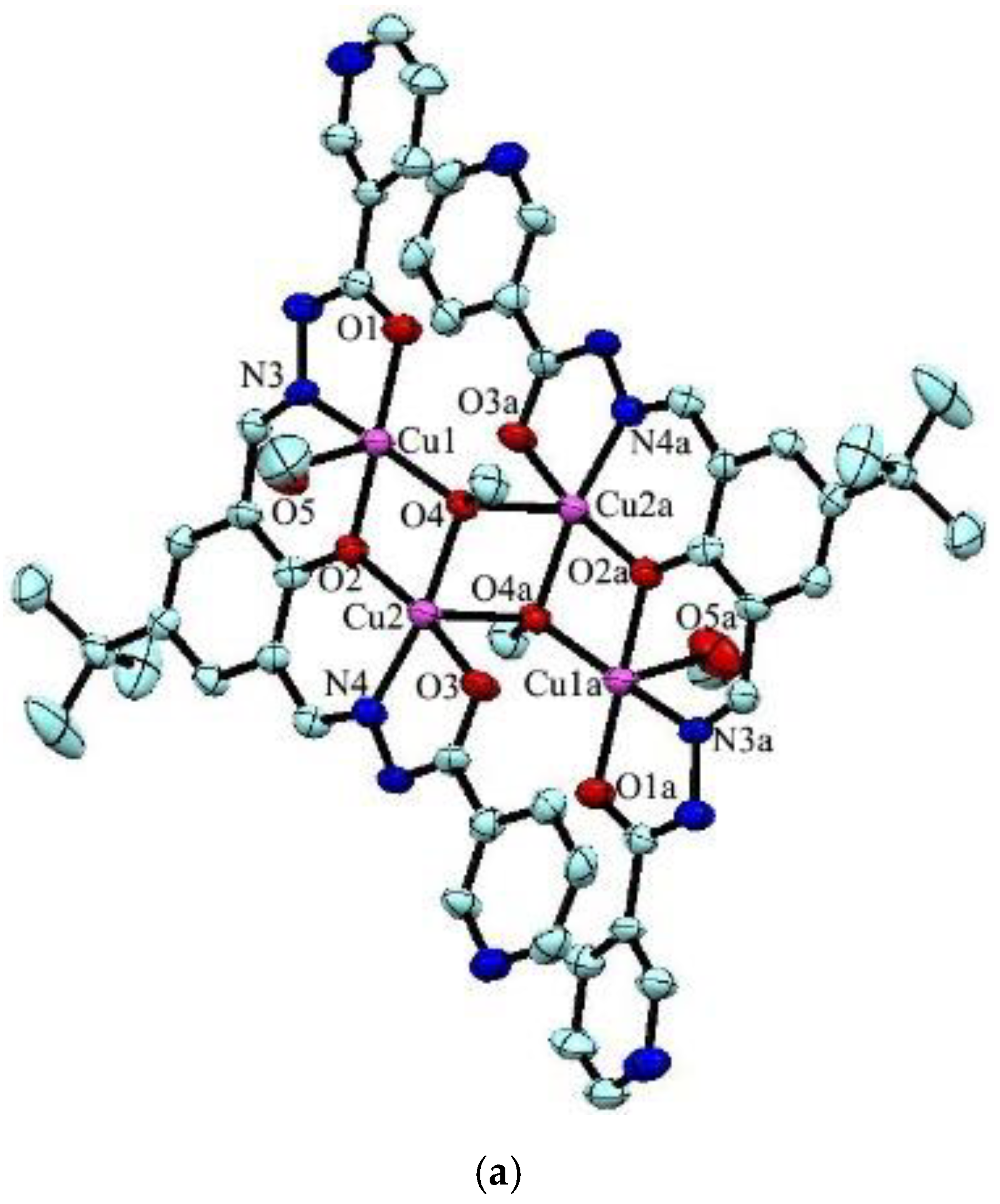

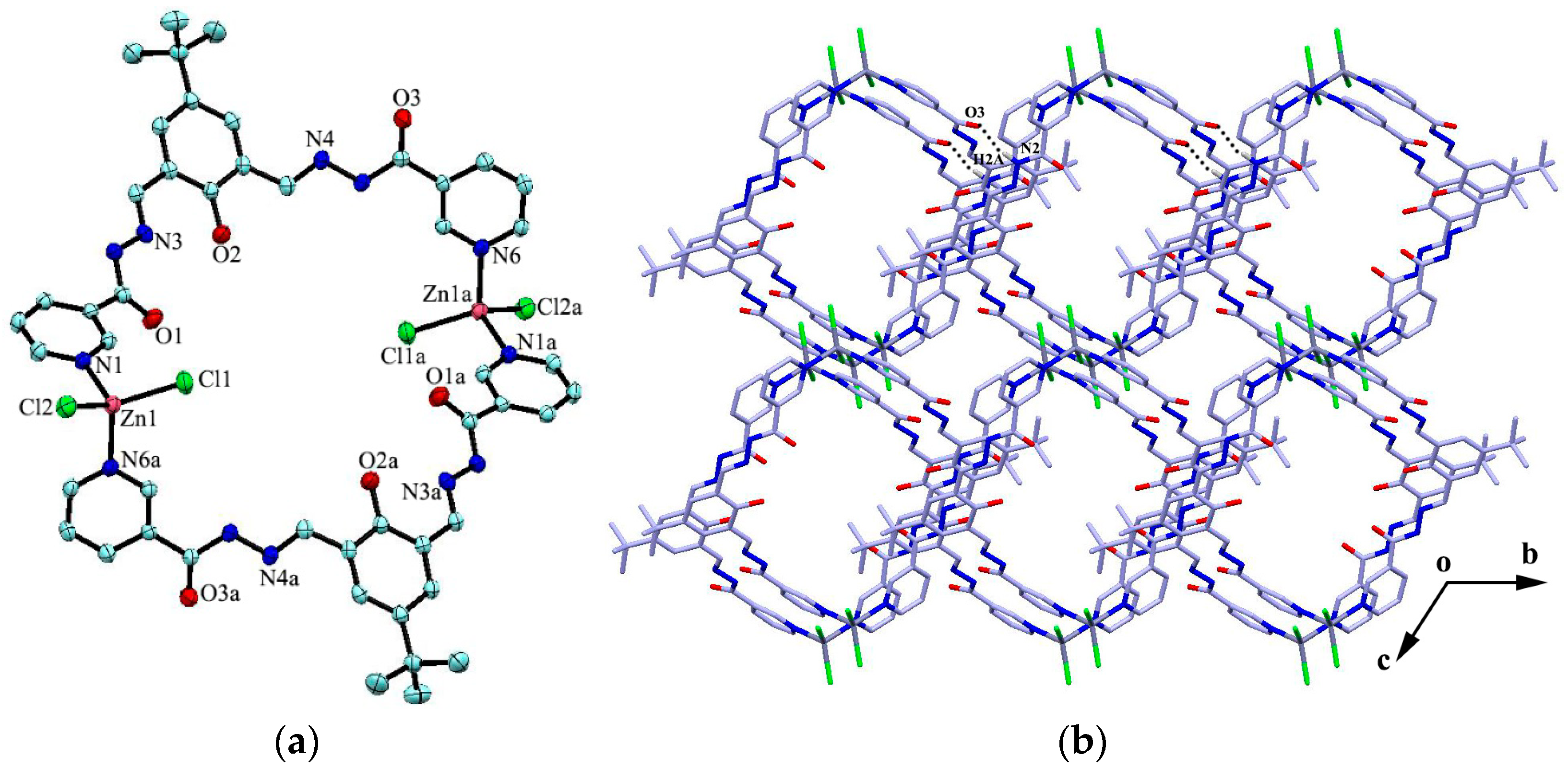
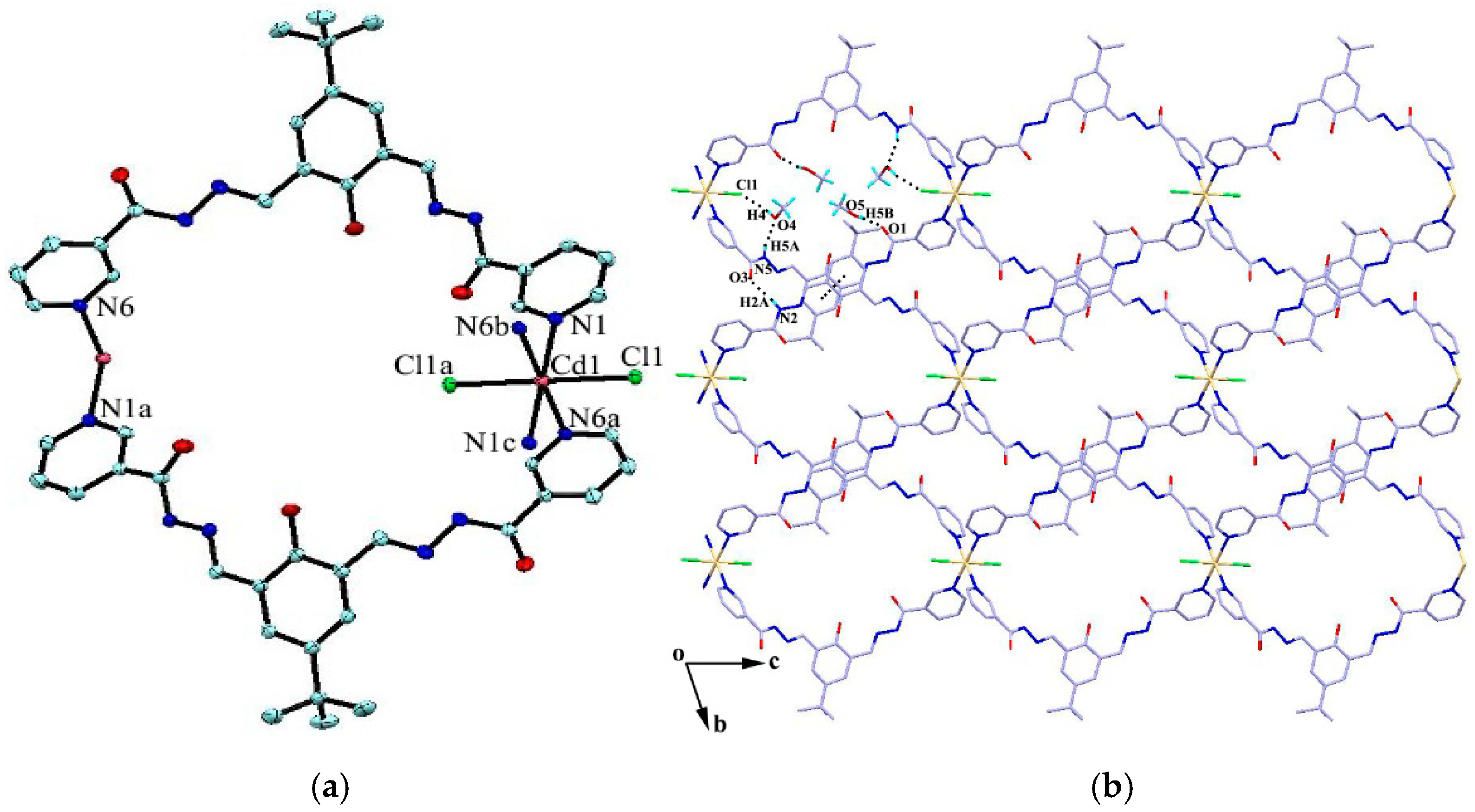
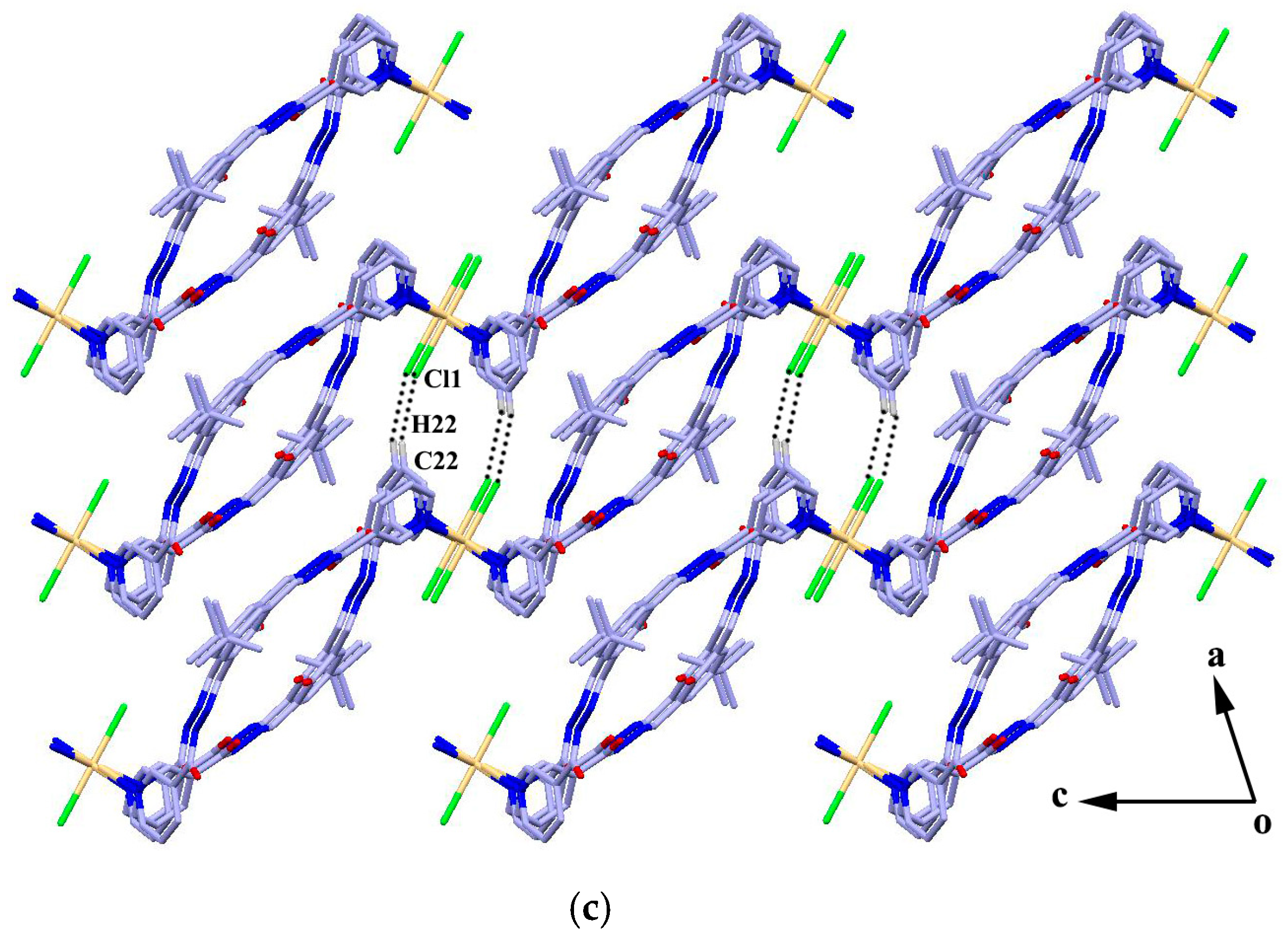
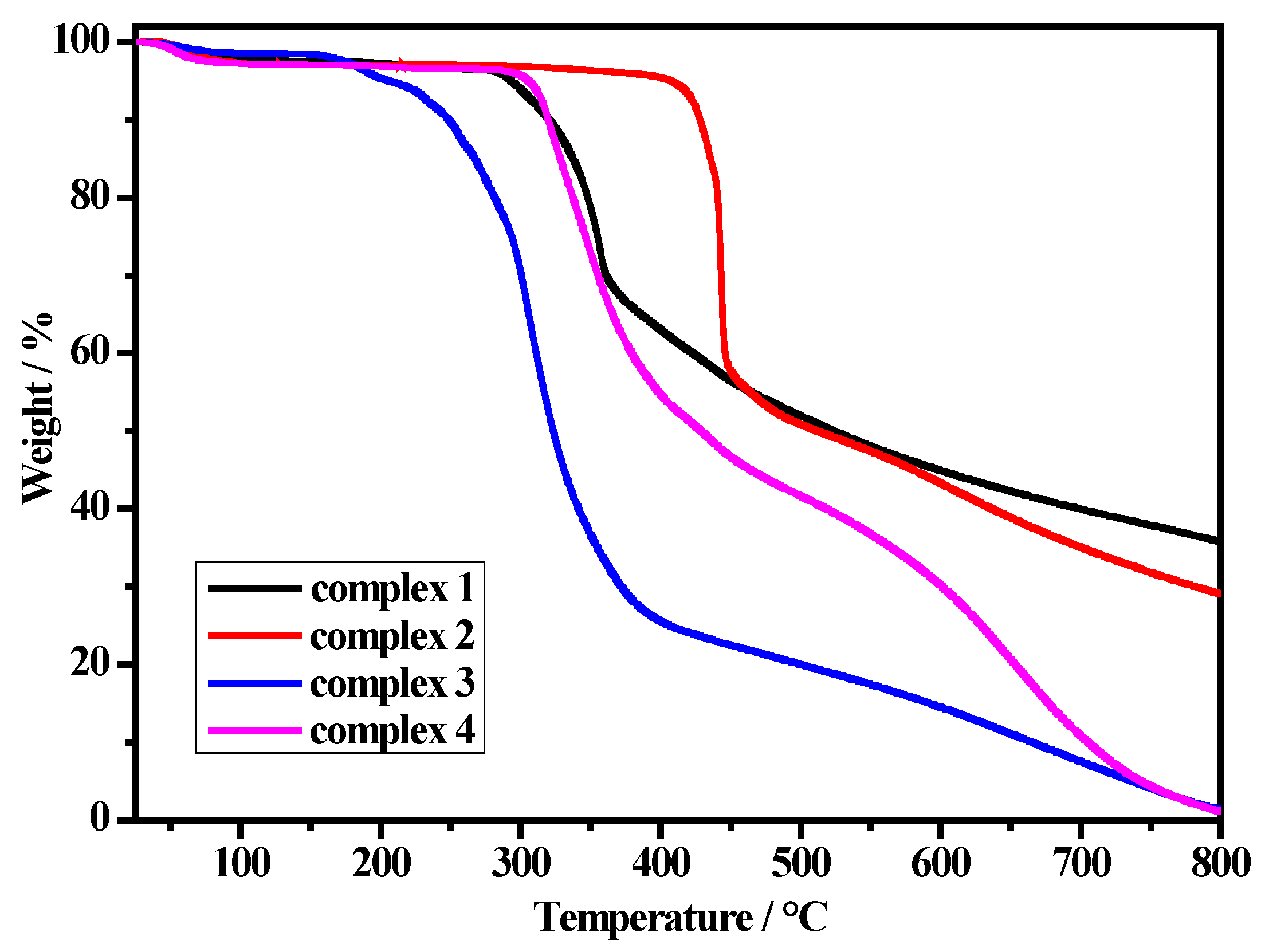
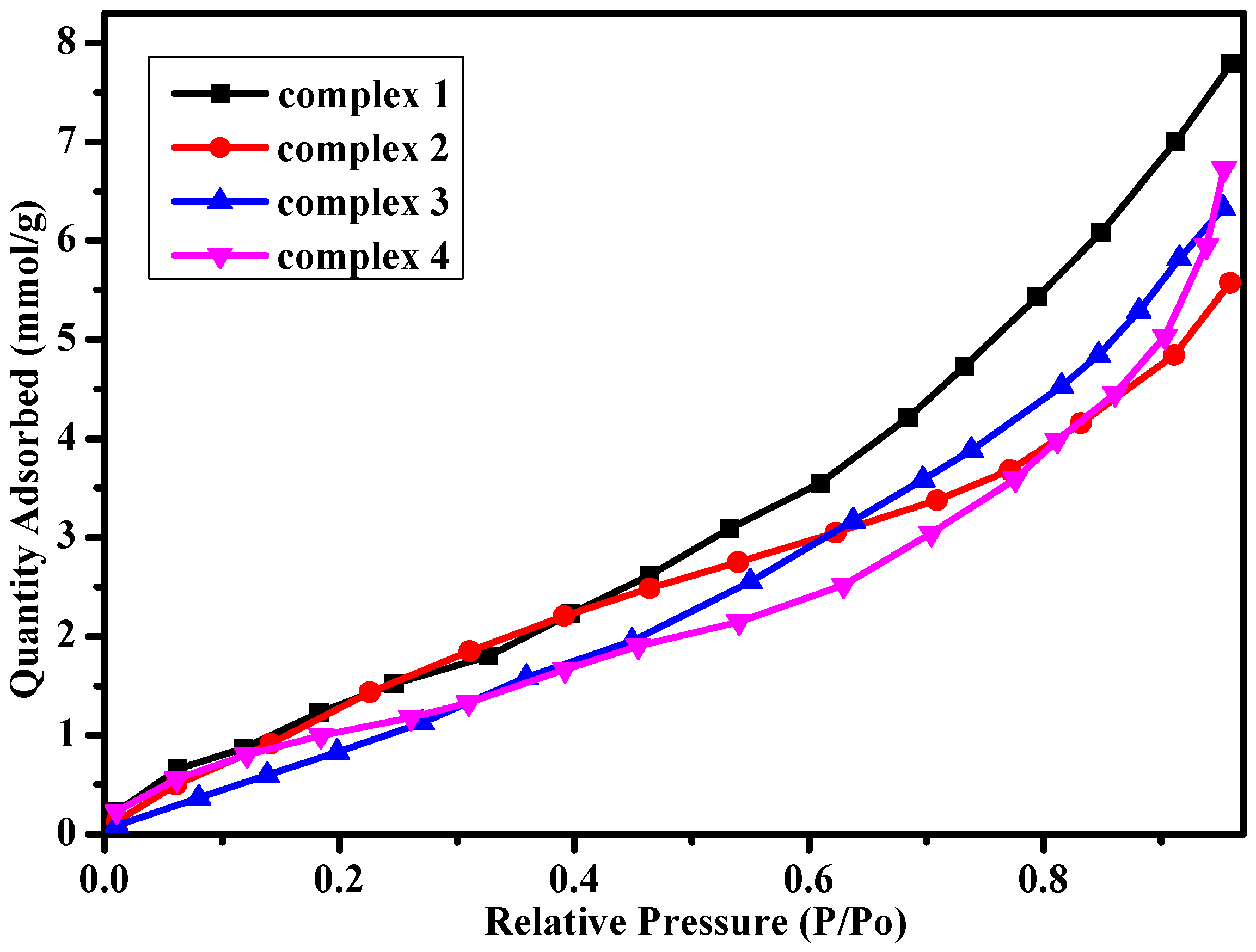
| Complex | 1 | 2 | 3 | 4 |
|---|---|---|---|---|
| Langmuir surface area (m2/g) | 687 | 398 | 489 | 496 |
| BET surface area (m2/g) | 585 | 309 | 355 | 372 |
| Complex | 1 | 2 | 3 | 4 |
|---|---|---|---|---|
| Empirical formula | C52H56Cu4N12O10 | C48H48Cl4N12O6Zn2 | C48H48Br4Hg2N12O6 | C52H64CdCl2N12O10 |
| Formula weight | 1263.24 | 1161.52 | 1609.80 | 1200.45 |
| Temperature/K | 273(2) | 273(2) | 223(2) | 223(2) |
| Crystal system | triclinic | triclinic | triclinic | triclinic |
| Space group | Pī | Pī | Pī | Pī |
| a/Å | 10.227(6) | 9.019(5) | 9.2634(6) | 8.9706(11) |
| b/Å | 11.498(7) | 12.473(7) | 12.7672(7) | 12.3790(15) |
| c/Å | 13.310(8) | 15.450(10) | 15.2183(9) | 15.0517(18) |
| α/(°) | 113.636(19) | 93.56(2) | 92.911(2) | 80.276(4) |
| β/(°) | 90.801(19)) | 103.431(19) | 102.156(2) | 83.890(5) |
| γ/(°) | 102.829(19) | 105.544(18 | 106.228(2) | 76.927(4) |
| V/Å 3 | 1388.7(15) | 1614.3(16) | 1677.81(17) | 1600.7(3) |
| Z | 1 | 1 | 1 | 1 |
| Dc/(g·cm−3) | 1.511 | 1.195 | 1.593 | 1.245 |
| θ range/(°) | 2.48 ≤ θ ≤ 24.00 | 2.04 ≤ θ ≤ 25.00 | 3.27 ≤ θ ≤ 25.00 | 2.58 ≤ θ ≤ 24.50 |
| Absorption coefficient/mm−1 | 1.578 | 0.957 | 6.998 | 0.483 |
| F(000) | 648 | 596 | 768 | 622 |
| Reflections collected | 26104 | 32817 | 29072 | 28266 |
| Independent reflections | 4358 | 5680 | 5846 | 5275 |
| Observed reflections (I > 2σ(I)) | 2454 | 4404 | 5282 | 4331 |
| Number of parameters | 361 | 329 | 329 | 357 |
| Goodness-of-fit on F 2 | 1.042 | 1.088 | 1.053 | 1.099 |
| Final R indices(I > 2σ(I)) | R1 = 0.0705, wR2 = 0.1701 | R1 = 0.0459, wR2 = 0.1318 | R1 = 0.0336, wR2 = 0.0895 | R1 = 0.0593, wR2 = 0.1319 |
| R indices (all data) | R1 = 0.1362, wR2 = 0.2020 | R1 = 0.0608, wR2 = 0.1397 | R1 = 0.0396, wR2 = 0.0920 | R1 = 0.0772, wR2 = 0.1403 |
| Largest diff. peak and hole (e Å−3) | 0.435, −0.530 | 0.380, −0.454 | 1.933, −1.229 | 0.673, −0.580 |
Publisher’s Note: MDPI stays neutral with regard to jurisdictional claims in published maps and institutional affiliations. |
© 2020 by the authors. Licensee MDPI, Basel, Switzerland. This article is an open access article distributed under the terms and conditions of the Creative Commons Attribution (CC BY) license (http://creativecommons.org/licenses/by/4.0/).
Share and Cite
Liu, H.-J.; Yi, R.; Chen, D.-M.; Huang, C.; Zhu, B.-X. Self-Assembly by Tridentate or Bidentate Ligand: Synthesis and Vapor Adsorption Properties of Cu(II), Zn(II), Hg(II) and Cd(II) Complexes Derived from a Bis(pyridylhydrazone) Compound. Molecules 2021, 26, 109. https://doi.org/10.3390/molecules26010109
Liu H-J, Yi R, Chen D-M, Huang C, Zhu B-X. Self-Assembly by Tridentate or Bidentate Ligand: Synthesis and Vapor Adsorption Properties of Cu(II), Zn(II), Hg(II) and Cd(II) Complexes Derived from a Bis(pyridylhydrazone) Compound. Molecules. 2021; 26(1):109. https://doi.org/10.3390/molecules26010109
Chicago/Turabian StyleLiu, Hong-Juan, Rui Yi, Dong-Mei Chen, Chao Huang, and Bi-Xue Zhu. 2021. "Self-Assembly by Tridentate or Bidentate Ligand: Synthesis and Vapor Adsorption Properties of Cu(II), Zn(II), Hg(II) and Cd(II) Complexes Derived from a Bis(pyridylhydrazone) Compound" Molecules 26, no. 1: 109. https://doi.org/10.3390/molecules26010109






